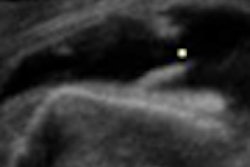While coding for obstetrical sonography can be a challenge, it's crucial to know the codes and keep up on coding trends, according to Dr. Joshua Copel, a professor of obstetrics-gynecology and pediatrics at Yale School of Medicine in New Haven, CT.
"Accuracy is important and is your responsibility," he said.
Copel provided a review of obstetrical sonography coding during a talk at the Leading Edge in Diagnostic Ultrasound meeting, held earlier this year in Atlantic City, NJ.
For first-trimester obstetrical sonography, practices should employ the 76801 code: ultrasound, pregnant uterus, real-time with image documentation, fetal and maternal evaluation, first trimester (<14 weeks, 0 days), transabdominal approach; single or first gestation. The 76802 code is utilized for each additional gestation and should be listed separately, in addition to the code for the primary procedure performed, Copel said.
In the second trimester, 76805 is used: ultrasound, pregnant uterus, real-time with image documentation, fetal and maternal evaluation, after first trimester (≥14 weeks, 0 days), transabdominal approach; single or first gestation. The 76810 code should be used for each additional gestation, he said.
Other codes that can be used during the second and third trimester include 76811, 76812, 76815, and 76816. The 76811 code covers ultrasound, pregnant uterus, real-time with image documentation, maternal evaluation plus detailed fetal anatomic examination, transabdominal approach; single or first gestation. Code 76812 should be used for each additional gestation and listed separately, Copel said.
The 76815 code is for ultrasound, pregnant uterus, real-time with image documentation, limited, one or more fetuses, he said. It should be used only once per exam and not per element.
"You cannot bill 76805 and 76810 simultaneously to 76815," he said. "They are mutually exclusive."
Physician interpretation and signed final reports are components of all of the codes, he said.
The 76816 code should be utilized for ultrasound, pregnant uterus, real-time with image documentation, follow-up (e.g., re-evaluation of fetal size by measuring standard growth parameters and amniotic fluid volume, re-evaluation of organ system or systems suspected or confirmed to be abnormal on a previous scan), transabdominal approach, per fetus, according to Copel. The code should be reported with the modifier "-59" for each additional fetus examined in a multiple pregnancy, he said.
If obstetrical sonography is performed when a patient returns at a later time, 76805 should be used if the scan is performed for a new indication. If not, 76816 should be employed, Copel said.
Code 76817 covers ultrasound, pregnant uterus, real-time with image documentation, transvaginal. The 76830 code should be used if gynecological transvaginal ultrasound is performed. In cases where the transvaginal examination is performed in addition to transabdominal obstetrical ultrasound, 76817 should be used in addition to the appropriate transabdominal code, Copel said.
For the fetal biophysical profile, 76818 should be used when the procedure is performed with nonstress testing, and 76819 should be used when it is performed without it, Copel said. Both codes include the physician interpretation and report.
Doppler obstetrical sonography codes include 76820 (umbilical artery Doppler), 76821 (middle cerebral artery Doppler), 76827 (echocardiography), and 93325 (color Doppler). The color Doppler code should be used with 76825, but not for finding the umbilical arteries, Copel said.
For 3D/4D obstetric sonography, 76376 covers multiplanar reconstruction of ultrasound, CT, MRI, or other tomographic modality using an ultrasound machine, Copel said. The 76377 code covers the same procedure but when offline reconstruction is performed.
Genetic or lung maturity amniocentesis is covered by 59000 and can be billed with 76946 for ultrasound guidance if you do it, he said. The 59001 code covers therapeutic amnioreduction; ultrasound guidance is included and should not be billed for separately.
Other obstetrical sonography codes include 59070 (transabdominal amnioinfusion), 59072 (umbilical cord occlusion), 59074 (fetal fluid aspiration), 59076 (fetal shunt placement), and 59897 (other unlisted fetal procedure).
For the nuchal translucency exam, 76813 covers the first fetus and 76814 should be used for each additional fetus.
Obstetrical sonography coding modifiers include "-22" (unusual complexity) and "-26" (professional component). Practices should only bill globally if they own or lease the machine, own or rent the space, and employ the sonographer, he said. "Otherwise, you must use '-26,' " he said.
ICD codes
With International Classification of Diseases (ICD) codes, know if your carriers pay attention, and use all that apply, he said. Copel also recommends prioritizing and trying not to use "V codes" (screening codes) as the primary indication.
Anatomy survey ICD codes include 653.12 (suspected/known chromosome abnormality), 649.53 (first pregnancy), 659.63 (two or more pregnancies), V23.81 (elderly primigravida), and V23.82 (elderly multigravida). In patients with history of congenital anomalies, 655.23 should be used in patients with suspected/known hereditary disease affecting the fetus. Code V19.5 covers a family history of congenital anomalies, he said.
ICD codes for fetal diseases include the following:
- 655.03 - Suspected/known central nervous system malformation
- 655.13 - Suspected/known chromosome anomaly
- 655.23 - Suspected/known hereditary disease
- 655.33 - Suspected/known damage from maternal viral disease
- 655.43 - Suspected/known damage from maternal disease (alcohol)
- 655.53 - Suspected/known damage from drugs
- 655.63 - Suspected/known damage from radiation
- 655.73 - Suspected/known decreased fetal movement
- 655.83 - Suspected/known fetal abnormality not elsewhere classified
Placenta-related ICD codes include 641.03 (placenta previa without hemorrhage), 641.13 (placenta previa with hemorrhage or pregnancy bleeding), 641.23 (placental abruption), and 656.73 (placenta, abnormal).
ICD codes related to fetal growth/fluid include 656.53 (size less than dates or intrauterine growth restriction [IUGR], suspected oligohydramnios), 656.63 (size greater than dates or macrosomia, suspected polyhydramnios), 657.03 (polyhydramnios), 658.03 (oligohydramnios), and V28.8 (dating/growth screening).
Other ICD codes of note include 654.13 (fibroids in pregnancy), 654.53 (incompetent cervix), 646.13 (excessive maternal weight gain), 646.83 (poor maternal weight gain), and V28.4 (screening for IUGR by ultrasound).
Also, ICD codes from 760 to 779.9 should not be used, as they are neonatal/pediatric codes, Copel said. "Use will result in automatic rejection of the claim," he said.
By Erik L. Ridley
AuntMinnie.com staff writer
August 27, 2008
Related Reading
CPT III codes for reimbursement: Surprising facts, August 7, 2008
Florida fraud case: A harbinger of increased federal scrutiny? April 30, 2008
Reimbursement 101: How vendors can help you get paid, August 24, 2007
New CMS rules could add to radiology's reimbursement woes, August 1, 2007
Simple steps to effective billing and coding audits, January 31, 2007
Copyright © 2008 AuntMinnie.com




















